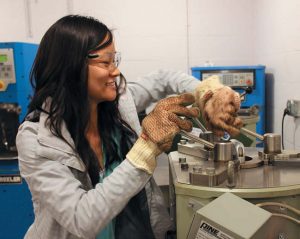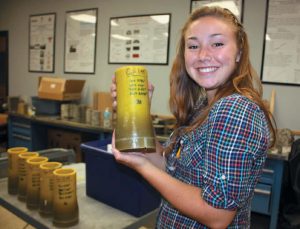Pavement Preservation Journal
Summer 2016, Vol. 9, No. 2
By Andrew Braham, P.E.
The University of Arkansas is developing a research group for pavement maintenance and pavement rehabilitation products, and student involvement is introducing pavement preservation concepts to a new generation.

Erica Yeung fabricates emulsion samples in the laboratory
The private sector has been very supportive of advancing this research program. One of the first tasks of this research group was developing the capabilities to make asphalt emulsions in the lab. Erica Yeung, current graduate student, began her master’s work in August 2015 and is in the process of finalizing her research proposal, which examines the interaction between asphalt emulsion and recycled asphalt pavement (RAP) reactivity.
After spending one summer working in an industry asphalt emulsion lab, she has strong expertise in fabricating asphalt emulsion at a lab scale. This is very important, as most university laboratories rely solely on industry to provide asphalt emulsion samples, so they have little control over the emulsion formulation, and all of the emulsions must be shipped before use.
Therefore, Yeung’s first task as a graduate student was getting the bench-top scale Herbert Rink asphalt emulsion mill up and running. Next, she will be crushing RAP in the lab, and understanding how (if any) charge is built on the RAP during the crushing process.
By utilizing different types of asphalt emulsions (with different emulsifiers), she will be able to determine how the asphalt emulsion interacts with different levels of charged RAP. This will be quantified by compacting the cold-In-place recycling (CIR) samples in a Superpave gyratory compactor. In theory, the faster the breaking of the emulsion, the harder it will be to compact. While this study is still in the early stages, it should provide some much needed understanding of how asphalt emulsion interacts with charged aggregate, and if that relationship changes over time with milled roadways.

Kaisha Plambeck, an undergraduate research assistant, tests full depth reclamation
samples for moisture sensitivity
In addition to fabricating asphalt emulsion in the lab and studying different formulations and RAP reactivity, the project also examined how labs could potentially reduce the amount of material required for lab evaluation. Obtaining the proper amount of field samples for a full lab evaluation requires a tremendous amount of material. Yet the University of Arkansas is chronically short of storage space for materials, and buckets line every open area of space around the lab. Therefore, it would be tremendously useful if the amount of material necessary to understand the behavior of a material could be reduced.
Therefore, graduate student Alex Jackson examined three tests of varying physical size that captured the creep behavior of CIR (which is indirectly related to the potential to crack). In order to properly scale-down the samples, three different gradations were explored to see if samples would behave simply as if they were “shrunk” down to size, which reduces the potential issues associated with single pieces of RAP spanning the entire sample (this is officially called maintaining a representative volume element).
The research found that the smallest test configuration was able to capture the same differences between materials and temperatures as the largest test configuration, using only 1 percent of the materials by volume. So it appears to be possible to gain an understanding of cracking of CIR by only using a fraction of the material usually necessary for performance testing.
These research projects—including others involving full-depth recycling—are hopefully just the beginning of research in pavement preservation, pavement maintenance and pavement preservation at the University of Arkansas. To learn more, visit our website at www.andrewbraham.com
Braham is assistant professor, Department
of Civil Engineering, University of
Arkansas-Fayetteville





